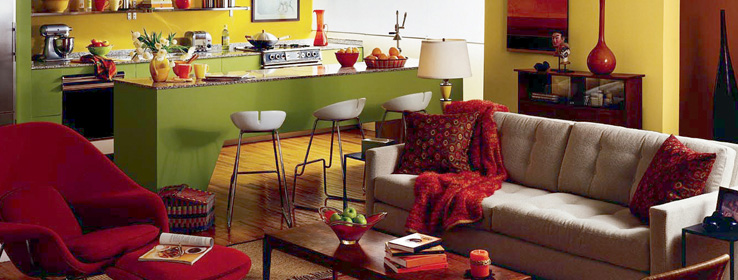Today's living spaces are doubling and even tripling their function without adding an extra square inch.
Many homeowners are breaking down €“ often literally €“ their kitchen, dining and living room walls in favor of large multipurpose rooms. Their home offices serve as guest bedrooms. They're creating "rec" rooms intended for a multitude of activities, such as homework, reading, music, exercise, crafts, laundry and additional TV-viewing.
"We're trying to accommodate a lot more functions in homes that often weren't built to serve them," says Sarah Susanka, a Raleigh, N.C., architect and interior designer and author of the books Inside the Not So Big House and Not So Big Solutions for Your Home.
Interior designer Kathy Adcock-Smith refers to the trend as "hiving." "People are doing more at home," she says, "they are multitasking with entertainment, food, theater and work."
To make rooms multitask successfully, the first step is to analyze and prioritize the functions you expect to happen in the room. "When you're planning a multipurpose space, think in terms of zones," advises Maxwell Gillingham-Ryan, a New York City interior designer and author of Apartment Therapy: The Eight-Step Home Cure. Then allocate an area €“ sometimes separate, sometimes overlapping €“ for each activity, and list the items you'll need to support those activities.
Expand With Color
Color is one of the best ways to manipulate space. Dark paint will appear to lower a ceiling and make walls advance, while light colors will make the ceiling and walls appear to recede. For all-in-one multipurpose living spaces, a cohesive color scheme pulls everything together and creates a feeling of airy spaciousness.
At the same time, color can help designate the separation of one functioning space from another in a large room. "You can break up a singular space with wall color," says Libby Langdon, New York City interior designer, author of Libby Langdon's Small Space Solutions: Stylish Design Ideas for Every Room€“Every Budget and expert commentator on Small Space, Big Style. "One end of the room is the living area and one end of the room is a dining area. Whatever end of the room it is, just paint it an accent color. Don't be afraid to be bold." Texture serves a similar purpose. For example, a "work" zone could be painted an energizing lemon yellow and decked out with smooth and glossy furnishings, while the "living" zone could be painted a restful leaf green with cushy textured furnishings that invite relaxation.
A change of color and texture in the flooring is also an effective way to define areas in a single space.
Maximize Light
Whether it's natural or other, the amount of light that's filtered through a large multipurpose room can make it appear larger and can also help delineate the space. Keeping the room visible all the way to every wall is the goal. "I would encourage people to make sure they're lighting all four corners of the room," says Langdon. "If it's not lit, you can't see it, and it's as though it's not even there."
If possible, incorporate a variety of lighting €“ natural, table lamps, ceiling lights, wall-mounted lights, recessed lighting, under-cabinet lighting €“ to both provide maximum illumination and to allow the room to serve all the functions it was designed for.
And don't forget that light can be reflected around the room with mirrors, making it appear brighter. But mirrors do more than just reflect light; they also reflect space, making the room look larger. A reflection, especially from an indirect angle, can help create the illusion of yet another room.
Use Versatile Furniture
Look for furnishings that allow rooms to morph from one function to another,"
Susanka advises.
Stacked tables, for instance, can be separated and serve as side tables when you have multiple guests over for a meal. An ottoman can serve as a footrest, coffee table or extra seating. A TV-room sofa can pull out to provide a bed for a houseguest. An armoire can stash a home office, an entertainment center, dishes and heirlooms, or clothes and toys.
"Instead of a coffee table, buy a chest with storage," recommends Hawaii-based interior designer Carol Kozlovich. The chest can also be a side table or even a bench by adding a cushion on top.
Portability is important, too: "Put furniture on casters so you can easily move it around €“ you need that mobility to make a multiuse space really function," says Langdon.
Incorporate Storage
Good storage is key to keeping a hardworking multipurpose room from becoming a chaotic mess. If square footage is tight, stretch bookcases, cabinets and open shelving to the ceiling to super-size storage space without cutting into the room's footprint. "Any time you can go floor-to-ceiling, you gain so much storage €“ and visually enlarge the space," Langdon says.







